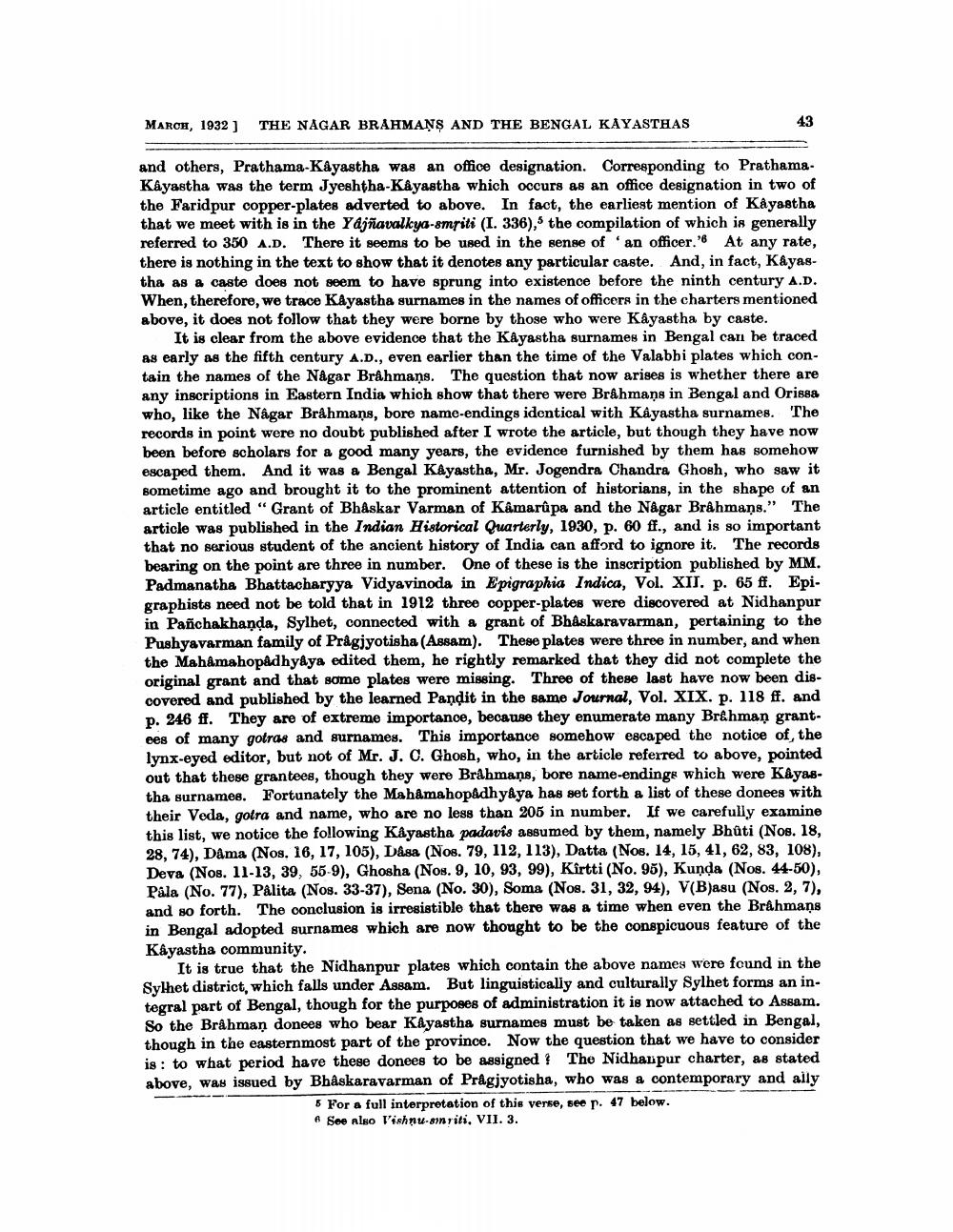________________
MARCH, 1932 ) THE NAGAR BRAHMANS AND THE BENGAL KAYASTHAS
43
and others, Prathama-Kayastha was an office designation. Corresponding to PrathamaKayastha was the term Jyeshtha-Kayastha which occurs as an office designation in two of the Faridpur copper-plates adverted to above. In fact, the earliest mention of Kayastha that we meet with is in the Yajnavalkya-8mpiti (I. 336),' the compilation of which is generally referred to 350 A.D. There it seems to be used in the sense of an officer.' At any rate, there is nothing in the text to show that it denotes any particular caste. And, in fact, K&yagtha as a caste does not seem to have sprung into existence before the ninth century A.D. When, therefore, we trace Kayastha surnames in the names of officers in the charters mentioned above, it does not follow that they were borne by those who were Kayastha by caste.
It is clear from the above evidence that the Kayastha surnames in Bengal can be traced as early as the fifth century A.D., even earlier than the time of the Valabbi plates which contain the names of the Någar Brahmans. The question that now arises is whether there are any inscriptions in Eastern India which show that there were Brahmans in Bengal and Orissa who, like the Nâgar Brâhmans, bore name-endings identical with Kayastha surnames. The records in point were no doubt published after I wrote the article, but though they have now been before scholars for a good many years, the evidence furnished by them has somehow escaped them. And it was a Bengal Kayastha, Mr. Jogendra Chandra Ghosh, who saw it sometime ago and brought it to the prominent attention of historians, in the shape of an article entitled "Grant of Bhaskar Varman of Kâmarûpa and the Någar Brâhmans." The article was published in the Indian Historical Quarterly, 1930, p. 60 ff., and is so important that no serious student of the ancient history of India can afford to ignore it. The records bearing on the point are three in number. One of these is the inscription published by MM. Padmanatha Bhattacharyya Vidyavinoda in Epigraphia Indica, Vol. XII. p. 65 ff. Epigraphists need not be told that in 1912 three copper-plates were discovered at Nidhanpur in Pañchakhanda, Sylhet, connected with a grant of Bhaskaravarman, pertaining to the Pushyavarman family of Pragjyotisha (Assam). These plates were three in number, and when the Mahamahopadhyaya edited them, he rightly remarked that they did not complete the original grant and that some plates were missing. Three of these last have now been discovered and published by the learned Pandit in the same Journal, Vol. XIX. p. 118 ff. and p. 246 ff. They are of extreme importance, because they enumerate many Brehman grantees of many gotras and surnames. This importance somehow escaped the notice of the lynx-eyed editor, but not of Mr. J. C. Ghosh, who, in the article referred to above, pointed out that these grantees, though they were Brahmans, bore name-endinge which were K&yastha surnames. Fortunately the Mahamahopadhyâya has set forth a list of these donees with their Veda, gotra and name, who are no less than 205 in number. If we carefully examine this list, we notice the following Kayastha padavis assumed by them, namely Bhüti (Nos. 18, 28, 74), Dama (Nos. 16, 17, 105), Dasa (Nos. 79, 112, 113), Datta (Nos. 14, 15, 41, 62, 83, 108), Deva (Nos. 11-13, 39, 55-9), Ghosha (Nos. 9, 10, 93, 99), Kîrtti (No. 95), Kunda (Nos. 44-50), Pala (No. 77), PAlita (Nos. 33-37), Sena (No. 30), Soma (Nos. 31, 32, 94), V(B)asu (Nos. 2,7), and so forth. The conclusion is irresistible that there was a time when even the Brahmans in Bengal adopted surnames which are now thought to be the conspicuous feature of the Kayastha community.
It is true that the Nidhanpur plates which contain the above names were found in the Sylhet district, which falls under Assam. But linguistically and culturally Sylhet forms an integral part of Bengal, though for the purposes of administration it is now attached to Assam. So the Brahman donees who bear Kayastha surnames must be taken as settled in Bengal, though in the easternmost part of the province. Now the question that we have to consider is : to what period have these donees to be assigned The Nidhanpur charter, as stated above, was issued by Bhaskaravarman of Pragjyotisha, who was a contemporary and ally
6 For a full interpretation of this verse, see r. 47 below. See Also l'ishnu-sinriti, VII. 3.




